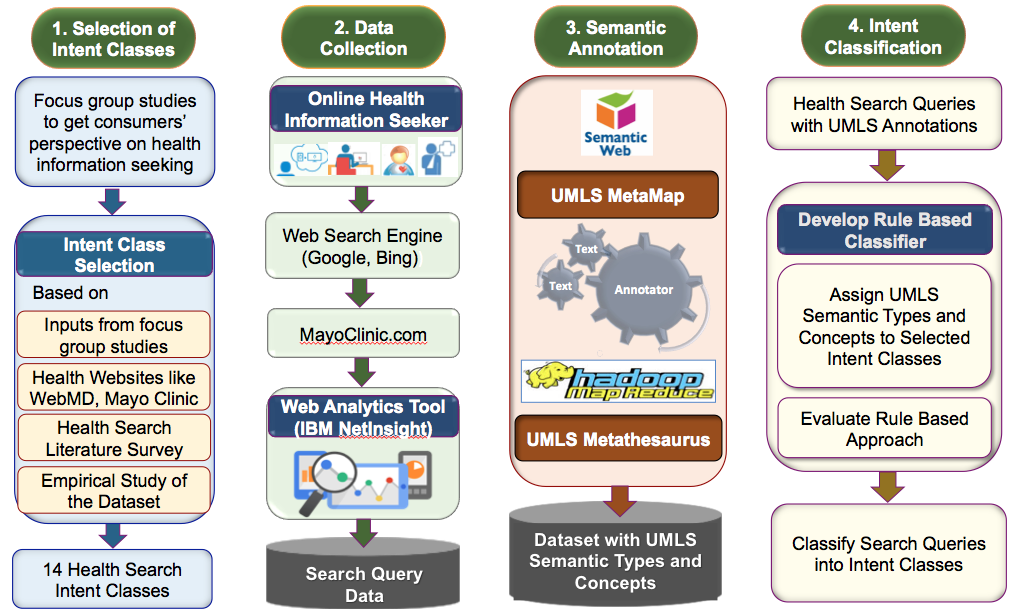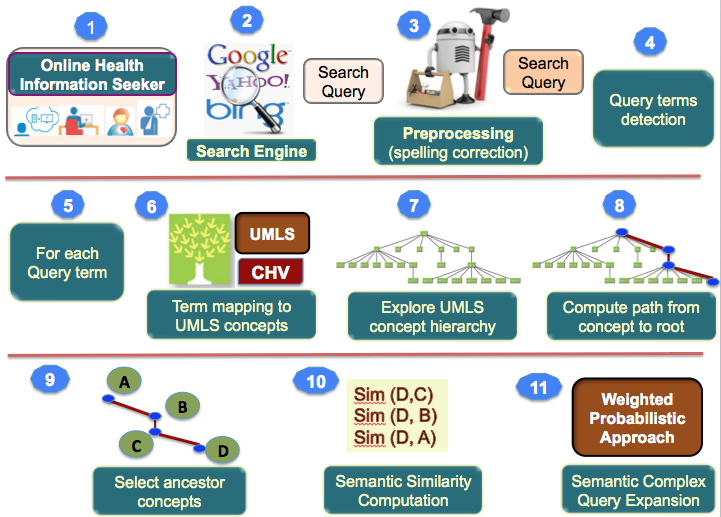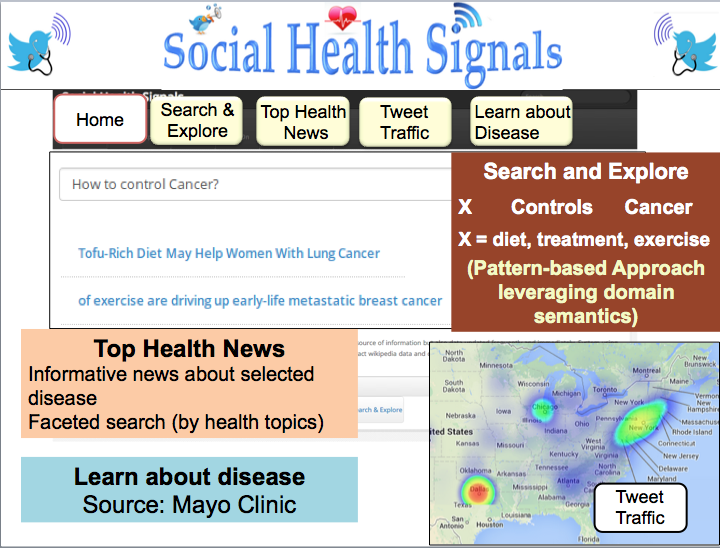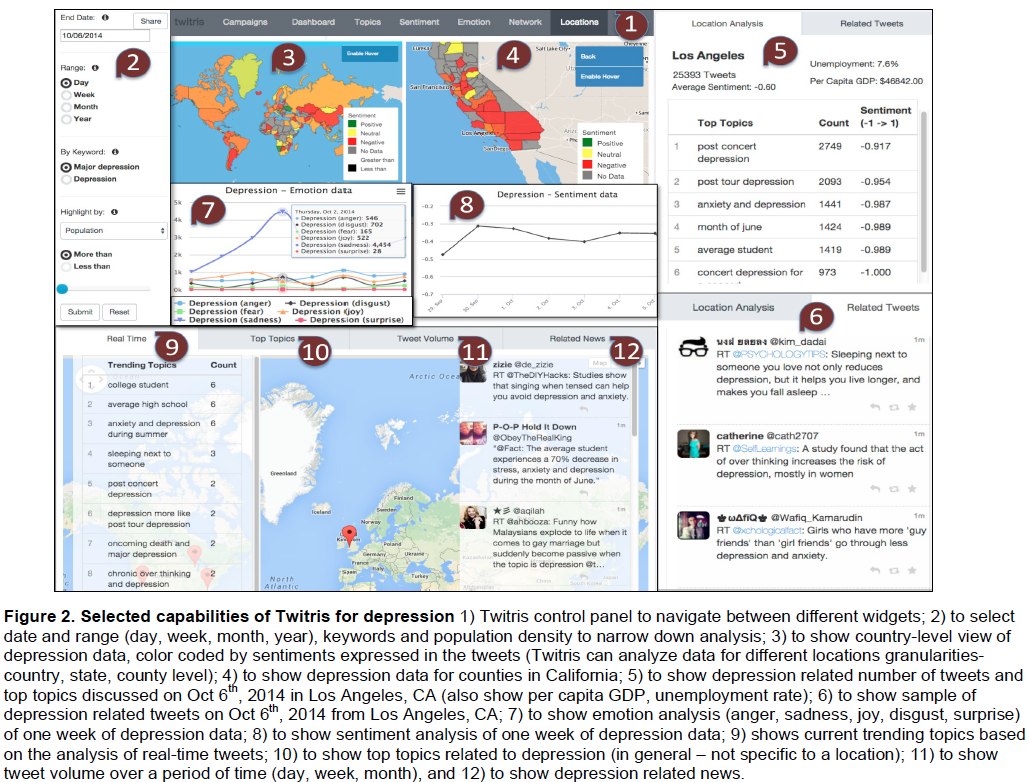Ashutosh Jadhav
Graduate Research Assistant - Kno.e.sis - Ohio Center of Excellence in Knowledge-enabled Computing
Ph.D. Candidate - Computer Science and Engineering Department, Wright State University
Advisor - Dr. Amit Sheth
Research interest: Search Intent Mining, Social Media Analytics, Health Informatics, Text Analytics, Semantic Web, Search Log Analysis, Knowledge Extraction and Utilization
Contents
[hide]- 1 Education and Work Experience
- 2 Research Projects
- 2.1 Search Intent Mining
- 2.2 Semantic Query Expansion
- 2.3 Social Health Signals
- 2.4 Twitris- Social Media Analytics and Research Platform, Demo
- 2.5 Device Effect on Online Information Seeking
- 2.6 Context-aware Content Recommendation in Enterprise Social Network
- 2.7 Disaster Situation Awareness based on Social Media Analysis
- 2.8 Wikipedia Knowledge Extraction
- 3 Technical Skills
- 4 Publications
- 5 Research Grants and Proposals
- 6 Selected Coursework
- 7 Mentorship
- 8 Professional Activities
- 9 Selected Presentations and Talks
- 10 Contact Information
- 11 Research Funding Acknowledgement
Education and Work Experience
Education
- Ph.D. Candidate, Computer Science and Engineering, Wright State University, April 2009 - Present
- Big Data & Smart Data Science Certification from Computer Science Department, Wright State University, Dayton, OH, May 2015
- M.S., Computer Engineering, Wright State University, November 2008
- B.E., Information Technology, VJTI , Mumbai University , June 2006
Work Experience
- Graduate Research Assistant at Kno.e.sis - Ohio Center of Excellence in Knowledge-enabled Computing, Wright State University (April. 2009 - Present)
- Develop research, problem-solving and analytical skills, learning ‘how to learn’ while working on collaborative, multidisciplinary projects, and real world research problems
- Projects: Search Intent Mining, Semantic Query expansion, Social Health Signals and Twitris
- Advisor: Prof.Amit Sheth
- Research Intern, Health Science Research, Mayo Clinic, Rochester, MN (May 2013 - May 2014)
- 1) Developed a consumer-centric health categorization framework using Semantic Web techniques 2) Semantic intent mining for health search, based on rich knowledge from UMLS and novel approach for semantic similarity computation 3) Qualitative analysis of online health information seeking using data science techniques
- Mentor: Dr.Jyotishman Pathak
- Research Intern, HP Services Research Lab, HP Labs, CA (June 11 – Sept 2011)
- Developed recommendation system leveraging content semantics to expedite enterprise Request for Proposal (RFP) response process.
- Mentor: Dr.Hamid Motahari Manager: Dr.Claudio Bartolini
- Graduate Teaching Assistant, Computer Science and Engineering Department, Wright State University (Sept 2009 - June 2010)
- Conducted programming lab sessions to guide computer science undergrads in Java programming and graded programming labs assignments and projects.
- Teaching Assistant and Grader, Computer Science and Engineering Department, Wright State University (Fall 2009)
- Software Developer Intern, Speedway SuperAmerica LLC, Enon, Ohio (June 2008 – Sept 2008)
- Worked with credit card transaction department on a database transaction integrity project involving the implementation of scripts to automatic verification and integrity/quality checks.
- Graduate Research Assistant, Data Mining Lab, Wright State University (Jan 2008 - June 2008)
- Advisor: Prof. Guozhu Dong
- Worked on efficiency (speedup) enhancement of a meta-search engine using Information Retrieval techniques
Research Projects
Search Intent Mining
- Motivation
- Understanding intent from search queries is crucial for designing an intelligent search engine. The objective of this project is to identify health information seeking intent from queries.
- Approach
- First, we conducted three qualitative focus group studies to get users’ perspective on online health information seeking. Second, I selected 14 consumer-oriented health search intent classes based on inputs from focus group studies and based on analysis of popular health websites, literature survey, and empirical study.
- Finally, I developed a semantic-driven rule-based intent framework for the identification of health seeking intent in disease agnostic manner. The framework is based on rich background knowledge from UMLS and utilizes UMLS semantic types and concepts.
- I developed the framework using Big Data technologies such as Hadoop-MapReduce, Hive, and HBase to process millions of search queries efficiently.
- Real World Application
- This framework will be integrated at Mayo Clinic to create user interest profiles based on their search history. The user profiling will be further used for personalized health information intervention, content recommendation, and targeted advertisements
Semantic Query Expansion
- Motivation
- The first step in search query processing is to understand user’s information need from the submitted search query and reformulating a seed query to improve retrieval performance (Query Expansion).
- Multiple IR studies have shown that a search engine’s performance degrades with an increase in the complexity of the search query.
- Approach
- In this project, I am specifically focusing on semantic expansion of complex health search queries (queries with multiple health concepts).
- I have used hyponymy and hypernymy relationships between health concepts to expand complex health search queries.
- I am extending current query expansion approaches by leveraging:
- Health domain semantics,
- Consumer health vocabulary,
- UMLS concept hierarchy, and
- Semantic similarity between health concepts (hyponymy and hypernymy).
- Examples
- Fosamax with red wine (original search query) => Fosamax wine or Fosamax alcohol
- heartburn in third trimester (original query) => heartburn pregnancy, acid reflux third trimester, etc.
Social Health Signals
- Objective
- The objective of this project is to understand and satisfy users’ need for keeping track of new information in the healthcare and well-being domain.
- The project harvests collective intelligence to aggregate high quality, reliable, and informative healthcare content shared over social media on one platform, Social Health Signals (SHS).
- Approach
- We utilized a hybrid approach based on rule-based filtering and supervised Machine Learning classification to facilitate identifying informative health-related information.
- Tool capabilities
- Retrieve relevant and reliable health information shared on Twitter in real-time.
- Question answering on Twitter data.
- Rank results based on relevancy, popularity and reliability.
- Efficient browsing of the results by semantically categorizing the information into health categories such as symptom, food and diet, healthy living, and prevention.
Twitris- Social Media Analytics and Research Platform, Demo
- Objective
- Twitris addresses information overload problem in social media by analyzing of large-scale social data and facilitates understanding of the social media content.
- Tool capabilities
- Twitris uses state-of-the-art technologies to
- Process real-time large scale social media streams,
- Extract meaningful signals from noisy social media data,
- Semantically integrate multiple complimentary web resources such as images, news, videos, and Wikipedia articles,
- Provide actionable insights, and
- Visualize processed information in Spatio-Temporal-Thematic, People-Content-Network and Sentiment-Emotion-Intent dimensions.
- Twitris uses state-of-the-art technologies to
- My Role
- I coordinated the development, analysis, and UI design for Twitris and Twitris 2.0. I contributed to the text analysis, information extraction, and information integration components of the system.
- Real World Application
- Twitris system has been used in multiple real world scenarios such as brand tracking (e.g. Apple, Macy’s), review monitoring (e.g. iPhone, movies), public event monitoring (e.g. US presidential election, state fairs), disaster situations (e.g. Japan earthquake) and health monitoring (e.g. swine flu, depression).
- Following are some of the articles on Twitris featured on news media
- SemanticWeb.com (November 8, 2012) Election 2012: The Semantic Recap
- SemanticWeb.com (August 3, 2012) Picking the President: Twindex, Twitris Track Social Media Electorate
- Mashable.com (February 17, 2012) Web App Analyzes Tweets in Real Time for a Record of Historic Events
- SemanticWeb.com (February 10, 2012) Twitris Social Media Analysis Tackles Occupy Wall Street, 2012 Elections
Device Effect on Online Information Seeking
- Motivation
- Personal computers (desktops, laptops) and smart devices (smartphones, tablets) have distinct characteristics in terms of readability, user experience, accessibility, etc.
- As search traffic from smart devices is exponentially increasing, it is critical to understand the effects of the device used for online information seeking.
- Such knowledge can be applied to improve the search experience and to develop more advanced next-generation knowledge and content delivery systems.
- Approach
- I used data science techniques to perform comparative analysis (such as structural, linguistic, textual and semantics analysis) of large-scale (more than 100 millions) health search queries submitted through Web search engines from both types of devices.
Context-aware Content Recommendation in Enterprise Social Network
Research Internship at HP Services Research Lab, HP Labs, CA
Claudio Bartolini (manager) and Hamid Motahari (mentor)
- Objective
- During my HP Labs internship, I worked on the ‘Semantic RFP Recommendation’ to expedite the Request for Proposal (RFP) response process at HP by making the right recommendations (past RFP and deal documents) at the right time.
- Approach
- I developed a recommender system using a semantic document similarity approach leveraging information about content (current and past documents), enterprise social networks (people and their roles), and stages of the RFP.
Based on my internship work, HP Labs filed a patent (83138852) on Context-Aware Deal Recommendations with myself being primary inventor.
Disaster Situation Awareness based on Social Media Analysis
- Objective
- The objective of this project was to expedite the decision-making process in disaster situations by identifying location-based, actionable information from social media.
- My Role
- I lead the research, design, and development for the project (funded by the Air Force Research Lab (AFRL)) to create a geo-social mash-up for situational awareness in a disaster situation based on social media data analysis.
Wikipedia Knowledge Extraction
- Objective
- This project aimed to generate a topic-specific domain model based on information available from Wikipedia.
- My Role
- I worked on the extraction of web-links (Wikipedia links and web URLs) mentioned on the whole corpus of Wikipedia articles as a part of Doozer, a tool for automatically creating a topic-specific domain model using curated knowledge from Wikipedia.
Technical Skills
- Programming: Java, PHP, HTML, XML, Shell scripting
- Big Data Technologies: Hadoop, MapReduce, Apache Storm, Spark
- Databases: MySQL, MS Access, Virtuoso triple store
- Semantic Web: OWL, RDF, SPARQL, Ontology
- Research Tools: Weka, Protege, Lucene, UMLS MetaMap, Google Analytics, IBM NetInsight
- Operating Systems: Mac OS, Linux, MS Windows
Big Data & Smart Data Science Certification from Computer Science Department, Wright State University, Dayton, OH
- To manage and analyze Big Data and to create Smart Data enabled applications for enterprises and individuals.
Publications
Google Scholar citation count: 135+
Journal Papers and Book Chapters
- Comparative Analysis of Online Health Queries Originating From Personal Computers and Smart Devices on a Consumer Health Information Portal
- Ashutosh Jadhav, Donna Andrews, Alexander S. Fiksdal, Ashok Kumbamu, Jennifer B. McCormick, Andrew Misitano, Laurie A. Nelsen, Euijing Ryu, Amit Sheth, Stephen Wu, Jyotishman Pathak
- Journal of Medical Internet Research (Impact factor 4.7) Link to Journal Paper
- Evaluating the Process of Online Health Information Searching: A Qualitative Approach to Exploring Consumer Perspectives
- Alexander S. Fiksdal, Ashok Kumbamu, Ashutosh Jadhav, Laurie A. Nelsen, Jyotishman Pathak, Jennifer B. McCormick
- Journal of Medical Internet Research (Impact factor 4.7) Link to Journal Paper
- Twitris- a System for Collective Social Intelligence
- Amit Sheth, Ashutosh Jadhav, Pavan Kapanipathi, Chen Lu, Hemant Purohit, Gary Alan Smith, Wenbo Wang
- Springer, Encyclopedia of Social Network Analysis and Mining (ESNAM), 2014
Conference Papers
- Analysis of Online Information Searching for Cardiovascular Diseases on a Consumer Health Information Portal
- Ashutosh Jadhav, Amit Sheth, Jyotishman Pathak
- AMIA Annual Symposium 2014, Washington DC, November 15-19, 2014
- Online Information Seeking for Cardiovascular Diseases: A Case Study from Mayo Clinic
- Ashutosh Jadhav, Stephen Wu, Amit Sheth, Jyotishman Pathak
- 25th European Medical Informatics Conference (MIE 2014), Istanbul, Turkey, August 31 - Sept 3, 2014
- Empowering Personalized Medicine with Big Data and Semantic Web Technology: Promises, Challenges, Pitfalls, and Use Cases
- Maryam Panahiazar, Vahid Taslimi, Ashutosh Jadhav, and Jyotishman Pathak
- IEEE International Conference on Big Data (IEEE BigData 2014), October 27-30, 2014, Washington DC, USA
- Twitris: Socially Influenced Browsing
- Ashutosh Jadhav, Wenbo Wang, Raghava Mutharaju, Pramod Anantharam, Vinh Nguyen, Amit P. Sheth, Karthik Gomadam, Meenakshi Nagarajan, and Ajith Ranabahu
- Semantic Web Challenge 2009, 8th International Semantic Web Conference, Oct. 25-29 2009, Washington, DC, USA
- Twitris 2.0: Semantically Empowered System for Understanding Perceptions From Social Data
- Ashutosh Jadhav, Hemant Purohit, Pavan Kapanipathi, Pramod Ananthram, Ajith Ranabahu, Vinh Nguyen, Pablo Mendes, Alan Gary Smith, Michael Cooney, Amit Sheth
- Semantic Web Challenge 2010, 9th International Semantic Web Conference, Shanghai, China, November 7-11, 2010.
- Spatio-Temporal-Thematic Analysis of Citizen-Sensor Data - Challenges and Experiences
- Meenakshi Nagarajan, Karthik Gomadam, Amit Sheth, Ajith Ranabahu, Raghava Mutharaju and Ashutosh Jadhav
- Tenth International Conference on Web Information Systems Engineering, Poland Oct 5-7, 2009
- Understanding Events Through Analysis Of Social Media
- Amit Sheth, Hemant Purohit, Ashutosh Jadhav, Pavan Kapanipathi and Lu Chen
- Technical Report, Kno.e.sis Center, 2010
Posters
- Comparative Analysis of Online Health Information Search by Device Type
- Ashutosh Jadhav, Jyotishman Pathak
- American Medical Informatics Association AMIA, TBI/CRI Joint Summit, San Francisco, USA, April 7-11, 2014
- An Analysis of Mayo Clinic Search Query Logs for Cardiovascular Diseases
- Ashutosh Jadhav, Amit Sheth, Jyotishman Pathak
- AMIA Annual Symposium 2014, Washington DC, November 15-19, 2014
- Social Health Signals
- Ashutosh Jadhav, Swapnil Soni, Amit Sheth
- Kno.e.sis Center, Technical Report, 2015
- What Information about Cardiovascular Diseases do People Search Online?
- Ashutosh Jadhav, Stephen Wu, Amit Sheth, Jyotishman Pathak
- 25th European Medical Informatics Conference (MIE 2014), Istanbul, Turkey, August 31 - Sept 3, 2014
- Twitris+: Social Media Analytics Platform for Effective Coordination
- A. Smith, A. Sheth, A. Jadhav, H. Purohit, L. Chen, M. Cooney, P. Kapanipathi, P. Anantharam, P. Koneru and W. Wang.
- National Science Foundation (NSF) SoCS Symposium, 2012
US Patent
- Context-Aware Information Recommendation, filed in January 2013 by HP Labs
- Patent filled based on HP summer 2011 internship work
- Ashutosh Jadhav, Hamid Motahari, Susan Spence, Claudio Bartolini (Role: Primary Investigator)
Research Grants and Proposals
(Significant contribution)
- NIH-R01 proposal (Award Amount: $1,934,525)
- Modeling Social Behavior for Healthcare Utilization and Outcomes in Depression
- In collaboration with Mayo Clinic and partly based on my Mayo Clinic internship work
- Air Force Research Lab (AFRL) proposals
- SIDFOT (Sensors Integration for Data Fusion in Operations and Training) project
- Title: Geo-Social mash-up for situational awareness in a disaster response situation
- Funded project: 2010-2011, Real-time Twitris
- Information Operations/Cyber Exploitation Research (ICER) Program, City Beat
- Title: Social media analysis for situational awareness
- Funded project: 2011-2012
- WBI's Tec^Edge Innovation and Collaboration Center (Tec^Edge ICC)
- Funded project: Summer 2010, Summer 2011
- SIDFOT (Sensors Integration for Data Fusion in Operations and Training) project
- Mayo Clinic Meritorious Awards
- Healthcare trend surveillance using social networks and health search queries (funded 2013)
- What makes a health-related tweet informative – patients’ perspective (funded 2014)
Selected Coursework
- Semantic Web
- Cloud Computing
- Data Mining
- Web 3.0 and Social Semantic Web
- Machine Learning
- Knowledge Representation for the Semantic Web
- Parallel Programming with MPI
- Distributed Computing Principles
- Web Information System
- Data Structures and Algorithms
- Database Systems and Design
- Advance Database Systems
- Computer Engineering Mathematics
- Computer Vision
- Advanced Computer Networks
- Multimedia Coding and Communication
- Comparative languages
- Computer Architecture I and II
Mentorship
- Amir Hossein Yazdavar
- Computer Science Ph.D.
- Topics related to Modeling Social Behavior for Depression (focus Twitter dataset)
- July 2015 - Present
- SoonJye Kho
- Visiting Research Scholar
- Topics related to Modeling Social Behavior for Depression (focus Twitter dataset)
- July 2015 - Present
- Swapnil Soni
- Computer Science Masters
- Thesis on topic related to Social Health Signals (Title: Domain Specific Document Retrieval Framework for Near Real-time Social Health Data)
- Jan. 2013– Present
- Nishita Jaykumar
- Computer Science Masters
- Project in Social Health Signals
- Jan. 2013 – Apr. 2013
- Sreeram Vallabhaneni
- PhD student
- Project: Semantic understanding of health related post shared on twitter
- Apr. 2012 – Aug. 2012
- Michael Cooney
- CS Undergrad
- Projects: Twitris, Disaster Situation Awareness
- 2010 – 2011
Professional Activities
- Student Research Consortium Chair at 11th International Conference on Data Integration in the Life Sciences 2015 (DILS2015)
- Reviewer AMIA Annual Symposium 2015
- Subreviewer for ICWSM 2011, 2012, 2013, 2014, 2015
- External sub-reviewer for World Wide Web 2013, ‘Social Networks and Graph Analysis’ track
- External reviewer for IEEE Internet Computing Magazine
- External reviewer for Semantic Web Journal
- Program Committee member for Semantic Web in Literature-Based Discovery workshop at IEEE International Conference on Bioinformatics and Biomedicine (BIBM 2012)
Selected Presentations and Talks
- Consumer-centric Health Informatics and Social Media Analytics, Mayo Clinic, Rochester, MN, USA, May 2015
- Disaster data informatics for situation awareness (950+ slideshare views)
- Twitris – System for Understanding Perceptions From Social Data (400+ slideshare views)
- Semantic Analysis of Online Health Information Seeking for Cardiovascular Diseases, AMIA Annual Symposium, Washington DC, USA 2014
- Semantic Intent Mining for Health Search, European Medical Informatics Conference (MIE 2014), Istanbul, Turkey
- Social Health Data Informatics, Symplur - Connecting the dots in healthcare social media and PatientsLikeMe
- Context-Aware Content Recommendation In Enterprise Pursuit Process, HP Labs, Palo Alto, CA, USA 2011
- Enterprise Social Network: State of the Art, presented at HP Labs, Palo Alto, CA, USA 2011
Contributed significantly in the following presentations
- Semantic Social Mash-up Approach for Designing Citizen Diplomacy (1350+ slideshare views)
- World Wide Web 2011 tutorial on Citizen Sensor Data Mining and Social Media Analytics (7,200+ slideshare views)
- Healthcare innovations at Kno.e.sis (800+ sideshare views)
Contact Information
- Ashutosh Jadhav
- Email: ashutosh@knoesis.org
- 380 Semantic Web lab, Joshi Research Center, Wright State University, 3640 Colonel Glenn Hwy, Dayton, Ohio 45435-0001
Ashutosh Jadhav Resume
Research Funding Acknowledgement
I will like to acknowledge Kno.e.sis Center, National Science Foundation (NSF), National Institutes of Health (NIH), and United States Air Force Research Laboratory (AFRL) for their generous support for my research work.




